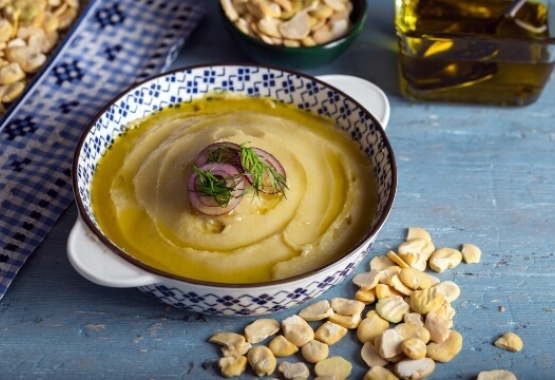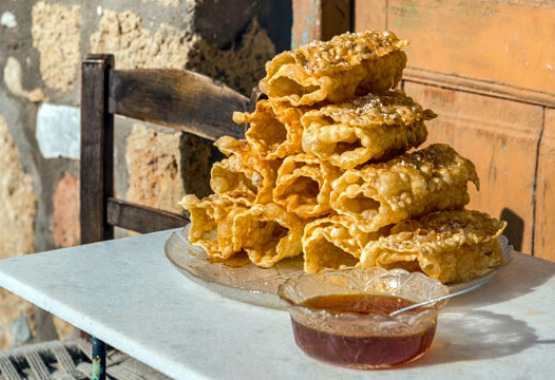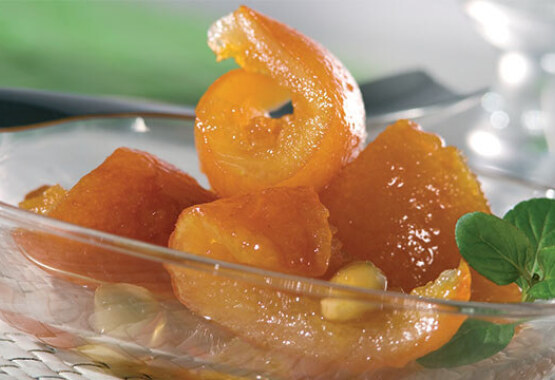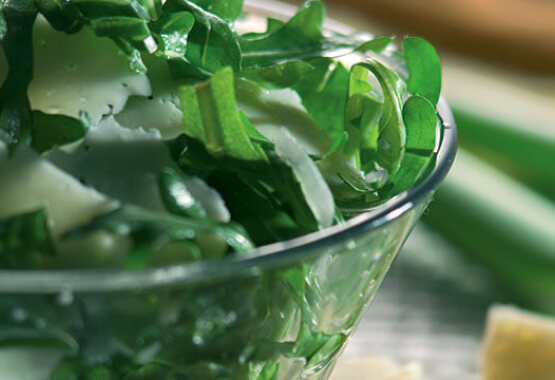
AROUND GREECE
Passion and skills may be needed for rolling-out a homemade traditional phyllo-sheet but with some practice it ain’t such a difficult task.
Greek imagination has created a large number of combinations in pie filling: cheese pie, spinach pie, leek pie, meat pie, mincemeat pie, mushroom pie, onion pie, chicken pie, cabbage pie, potato pie, pasta pie, nettle pie, pastourma pie or pumpkin pie the different variations are unlimited!
Take note of which pies you must taste on your next visit to Greece. In Thessaloniki try the savoury sweet or salty bougatsa. On Kefalonia Island don’t miss their traditional meat and cod fish pies. Lefkada Island has its own fish pie the tasteful maridopita (a picarel pie). On Skopelos Island their renowned strifti (meaning twisted) pie and on Skyros Island taste marmarites pie (which is a phyllo-sheet folded in a triangular shape and filled with a mixture of pumpkin, onions, cheese, cinnamon and peppermint). On Mykonos Island taste the onion pie, on Kimolos Island try ladenia and on Karpathos Island their delicious cabbage pie. Don’t forget to taste gkiouzlemedes on Lesvos Island and if you visit Crete taste Tzoulama at the valley of Messara and Boureki in Chania.
At Zagorochoria order a flour pie, in Thessaly a plasto (leek and feta pie with cornbread crust), in Karditsa a batzina (pumpkin pie), in Epirus a kothropita and pepeki. If you go by Ioannina taste their savoury batsaria (made with cornflour, various wild greens, flour and milk) and if you reach Preveza try blatsara (made with chives, feta and cornflour).
If you want to satisfy your sweet tooth, besides bougatsa, taste the flavourful milk pie from Thessaly, rice pie from Zagorochoria, honey pie from Sifnos and rice and red pumpkin pie from Pelion. Last but not least taste sfakiani pita on Crete served both salty or sweet by simply pouring some mouth-watering honey on top.
Savoury pies
Greeks love their pies; you can find them in all sort of shapes, salty or sweet, traditional or not, with thin pastry phyllo-sheets or crumbly, richer and thicker ones.
Greek pies are a culinary masterpiece that have a large variety of scrumptious combinations! They express the Greek spirit by using simple ingredients. They are excellent as a side dish for an elegant dinner or even as a simple snack at work!Phyllo Sheets: The Greek Way
What characterises a traditional Greek pie (pita in greek) is its phyllo-sheets undoubtedly made of fresh homemade ingredients. All phyllo-sheets are not made the same way! Different processes are carried out to give each pastry-sheet a different texture; sometimes thick, rich and crumbly and sometimes thin and translucent. There are pies made with a large number of sheets, layered one on top of the other and filled with scrumptious ingredients like cheese and vegetables. There are other ones that with a simple semi-liquid mixture of flour and other tasteful ingredients, replace the usual top and bottom usage of phyllo-sheets.Passion and skills may be needed for rolling-out a homemade traditional phyllo-sheet but with some practice it ain’t such a difficult task.
Pie filling can include almost anything!
Besides having a wide variety in pastry-sheets, the pie filling variations will surprise you! They are based on the cook’s ingenuity and origin. Everything can become filling for a pie; cheese, greens (horta in greek), vegetables, meat, fish, pasta, rice or trahana (a granular grain product made with either semolina/wheat flour/bulgur/cracked wheat mixed with either milk/yogurt/buttermilk) are just some of the delicious products that will give the pie a taste lift.Greek imagination has created a large number of combinations in pie filling: cheese pie, spinach pie, leek pie, meat pie, mincemeat pie, mushroom pie, onion pie, chicken pie, cabbage pie, potato pie, pasta pie, nettle pie, pastourma pie or pumpkin pie the different variations are unlimited!
A traditional treat in every little part of Greece
Every pie in Greece either it originates from a village or city, an island or mainland differs depending on its shape, cooking, size and filling! Either you visit Thrace, Macedonia, Thessaly, Epirus, Peloponnese, the islands or Crete they all have their own pie recipe, cooked in the oven or pan.Take note of which pies you must taste on your next visit to Greece. In Thessaloniki try the savoury sweet or salty bougatsa. On Kefalonia Island don’t miss their traditional meat and cod fish pies. Lefkada Island has its own fish pie the tasteful maridopita (a picarel pie). On Skopelos Island their renowned strifti (meaning twisted) pie and on Skyros Island taste marmarites pie (which is a phyllo-sheet folded in a triangular shape and filled with a mixture of pumpkin, onions, cheese, cinnamon and peppermint). On Mykonos Island taste the onion pie, on Kimolos Island try ladenia and on Karpathos Island their delicious cabbage pie. Don’t forget to taste gkiouzlemedes on Lesvos Island and if you visit Crete taste Tzoulama at the valley of Messara and Boureki in Chania.
At Zagorochoria order a flour pie, in Thessaly a plasto (leek and feta pie with cornbread crust), in Karditsa a batzina (pumpkin pie), in Epirus a kothropita and pepeki. If you go by Ioannina taste their savoury batsaria (made with cornflour, various wild greens, flour and milk) and if you reach Preveza try blatsara (made with chives, feta and cornflour).
If you want to satisfy your sweet tooth, besides bougatsa, taste the flavourful milk pie from Thessaly, rice pie from Zagorochoria, honey pie from Sifnos and rice and red pumpkin pie from Pelion. Last but not least taste sfakiani pita on Crete served both salty or sweet by simply pouring some mouth-watering honey on top.




